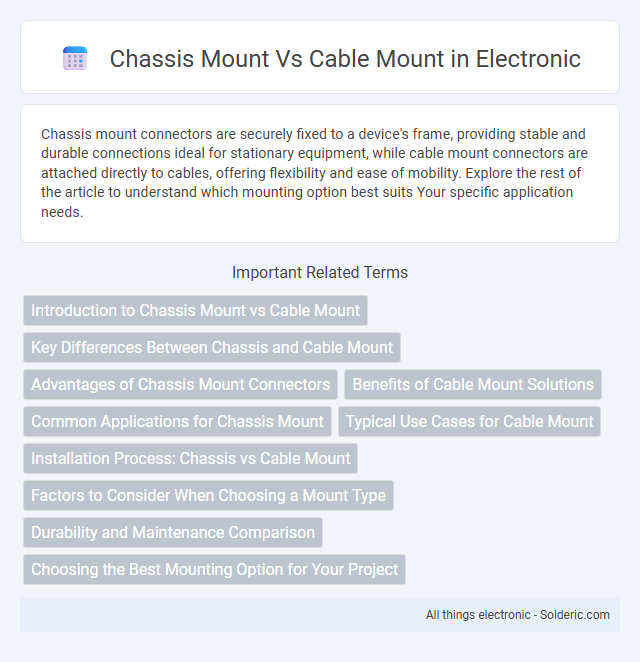Chassis mount connectors are securely fixed to a device's frame, providing stable and durable connections ideal for stationary equipment, while cable mount connectors are attached directly to cables, offering flexibility and ease of mobility. Explore the rest of the article to understand which mounting option best suits Your specific application needs.
Comparison Table
| Feature | Chassis Mount | Cable Mount |
|---|---|---|
| Installation | Mounted directly on chassis or equipment frame | Mounted on the cable for flexibility and mobility |
| Use Case | Fixed hardware connections in devices or panels | Dynamic or portable wiring applications |
| Durability | High durability, stable connection | Moderate durability, prone to wear from movement |
| Space Efficiency | Requires dedicated mounting space on chassis | Optimizes space by mounting on cable |
| Maintenance | Easier to access and maintain components | More challenging due to cable movement |
| Applications | Industrial control panels, fixed electronic assemblies | Flexible electronics, portable devices, field wiring |
Introduction to Chassis Mount vs Cable Mount
Chassis mount connectors are secured directly to a device's enclosure, providing a stable and durable connection point ideal for fixed installations. Cable mount connectors attach to the end of a cable, offering flexible and portable connectivity suitable for field use and easy replacements. Choosing between chassis mount and cable mount depends on the application's requirements for durability, flexibility, and installation environment.
Key Differences Between Chassis and Cable Mount
Chassis mount connectors are fixed directly onto a panel or enclosure, providing a secure and stable connection point, while cable mount connectors are attached to the cable end, allowing for flexible and portable connectivity. The key differences lie in their installation: chassis mounts are designed for permanent fixture on equipment, whereas cable mounts enable easy connection and disconnection in dynamic setups. Your choice depends on whether you need stationary integration or flexible cable interfacing for your device.
Advantages of Chassis Mount Connectors
Chassis mount connectors offer superior durability and secure attachment, reducing the risk of disconnection in high-vibration environments. Their design facilitates easy panel integration and maintenance, providing stable electrical connections essential for industrial and automotive applications. You benefit from enhanced mechanical strength and reliable grounding due to their direct mounting on the chassis.
Benefits of Cable Mount Solutions
Cable mount solutions offer enhanced flexibility and ease of installation compared to chassis mount options, allowing for versatile placement in tight or irregular spaces. They reduce mechanical stress on connectors and cables, improving durability and reliability in dynamic environments. Choosing cable mounts can simplify maintenance and upgrades, saving you time and effort in complex wiring setups.
Common Applications for Chassis Mount
Chassis mount connectors are commonly used in industrial equipment, automotive systems, and telecommunications due to their robust attachment to a fixed panel, ensuring durability and stable connections in harsh environments. These mounts are ideal for applications requiring frequent plugging and unplugging, such as control panels, audio/video equipment, and networking hardware. Your choice of chassis mount ensures reliable performance where vibration and mechanical stress are common factors.
Typical Use Cases for Cable Mount
Cable mount connectors are commonly used in environments where flexible wiring and easy maintenance are essential, such as industrial machinery, robotics, and automotive applications. These connectors allow quick connection and disconnection of cables without disturbing the main chassis, enhancing operational efficiency and reducing downtime. Your systems benefit from cable mounts when flexibility and frequent reconfiguration are critical to performance.
Installation Process: Chassis vs Cable Mount
Chassis mount installation involves securing the device directly onto a panel or enclosure, offering a stable and permanent solution with minimal cable movement. Cable mount installation requires attaching the connector to a cable, providing flexibility and ease of replacement but often demands more precise cable management. You should consider the specific application to determine whether a fixed chassis mount or a more adaptable cable mount best suits your installation needs.
Factors to Consider When Choosing a Mount Type
When choosing between chassis mount and cable mount, consider factors such as installation environment, space constraints, and durability requirements. Chassis mounts provide robust support directly to equipment frames, ideal for fixed setups and minimizing cable strain. Cable mounts offer flexibility and ease of repositioning, making them suitable for dynamic or confined spaces where quick adjustments are necessary.
Durability and Maintenance Comparison
Chassis mount connectors offer superior durability due to their robust housing and secure attachment to a fixed surface, reducing strain on connections and minimizing wear over time. Cable mount connectors, while more flexible and easier to reposition, generally require more frequent maintenance because of their exposure to movement and environmental stress. Your choice depends on the need for long-term reliability with minimal upkeep or greater installation flexibility.
Choosing the Best Mounting Option for Your Project
Chassis mounts provide a secure and durable connection ideal for fixed installations, enhancing stability and reducing strain on cables in high-vibration environments. Cable mounts offer flexibility and ease of replacement, making them suitable for applications requiring frequent adjustments or limited space. Selecting the best mounting option depends on factors such as environmental conditions, mechanical stress, and maintenance accessibility.
Chassis mount vs Cable mount Infographic

 solderic.com
solderic.com